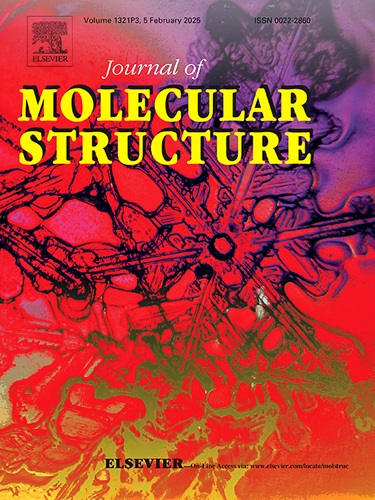Tetrahydropyrazolopyrazolones: Synthesis, X-ray crystallography and antimicrobial activity
IF 4
2区 化学
Q2 CHEMISTRY, PHYSICAL
引用次数: 0
Abstract
1,3-Dipolar cycloaddition is a valuable reaction for synthesizing heterocycles which form the core of pharmacophores with diverse bioactivities. In this study, structurally intriguing cis/trans pairs of 6-acyl-5-aryltetrahydropyrazolo[1,2-a]pyrazol-1(5H)-ones were synthesized via the 1,3-dipolar cycloaddition of N,N’-cyclic azomethine imines and vinyl-containing enones to assess their antimicrobial activity. The crystal structures of two cis and two trans tetrahydropyrazolopyrazolone derivatives were analyzed and their geometrical features were compared with structurally related compounds from the Cambridge Structural Database (CSD). The antimicrobial activity evaluation of the synthesized tetrahydropyrazolopyrazolones against bacteria and fungi revealed weak to moderate efficacy, with minimum inhibitory concentration (MIC) values ranging from 2 to 8 mM for most species. Notably, the compounds exhibited a stronger inhibitory effect on mold growth compared to Candida albicans. Furthermore, the tested compounds demonstrated greater efficacy against Gram-positive bacteria than Gram-negative bacteria.

求助全文
约1分钟内获得全文
求助全文
来源期刊

Journal of Molecular Structure
化学-物理化学
CiteScore
7.10
自引率
15.80%
发文量
2384
审稿时长
45 days
期刊介绍:
The Journal of Molecular Structure is dedicated to the publication of full-length articles and review papers, providing important new structural information on all types of chemical species including:
• Stable and unstable molecules in all types of environments (vapour, molecular beam, liquid, solution, liquid crystal, solid state, matrix-isolated, surface-absorbed etc.)
• Chemical intermediates
• Molecules in excited states
• Biological molecules
• Polymers.
The methods used may include any combination of spectroscopic and non-spectroscopic techniques, for example:
• Infrared spectroscopy (mid, far, near)
• Raman spectroscopy and non-linear Raman methods (CARS, etc.)
• Electronic absorption spectroscopy
• Optical rotatory dispersion and circular dichroism
• Fluorescence and phosphorescence techniques
• Electron spectroscopies (PES, XPS), EXAFS, etc.
• Microwave spectroscopy
• Electron diffraction
• NMR and ESR spectroscopies
• Mössbauer spectroscopy
• X-ray crystallography
• Charge Density Analyses
• Computational Studies (supplementing experimental methods)
We encourage publications combining theoretical and experimental approaches. The structural insights gained by the studies should be correlated with the properties, activity and/ or reactivity of the molecule under investigation and the relevance of this molecule and its implications should be discussed.
 求助内容:
求助内容: 应助结果提醒方式:
应助结果提醒方式:


